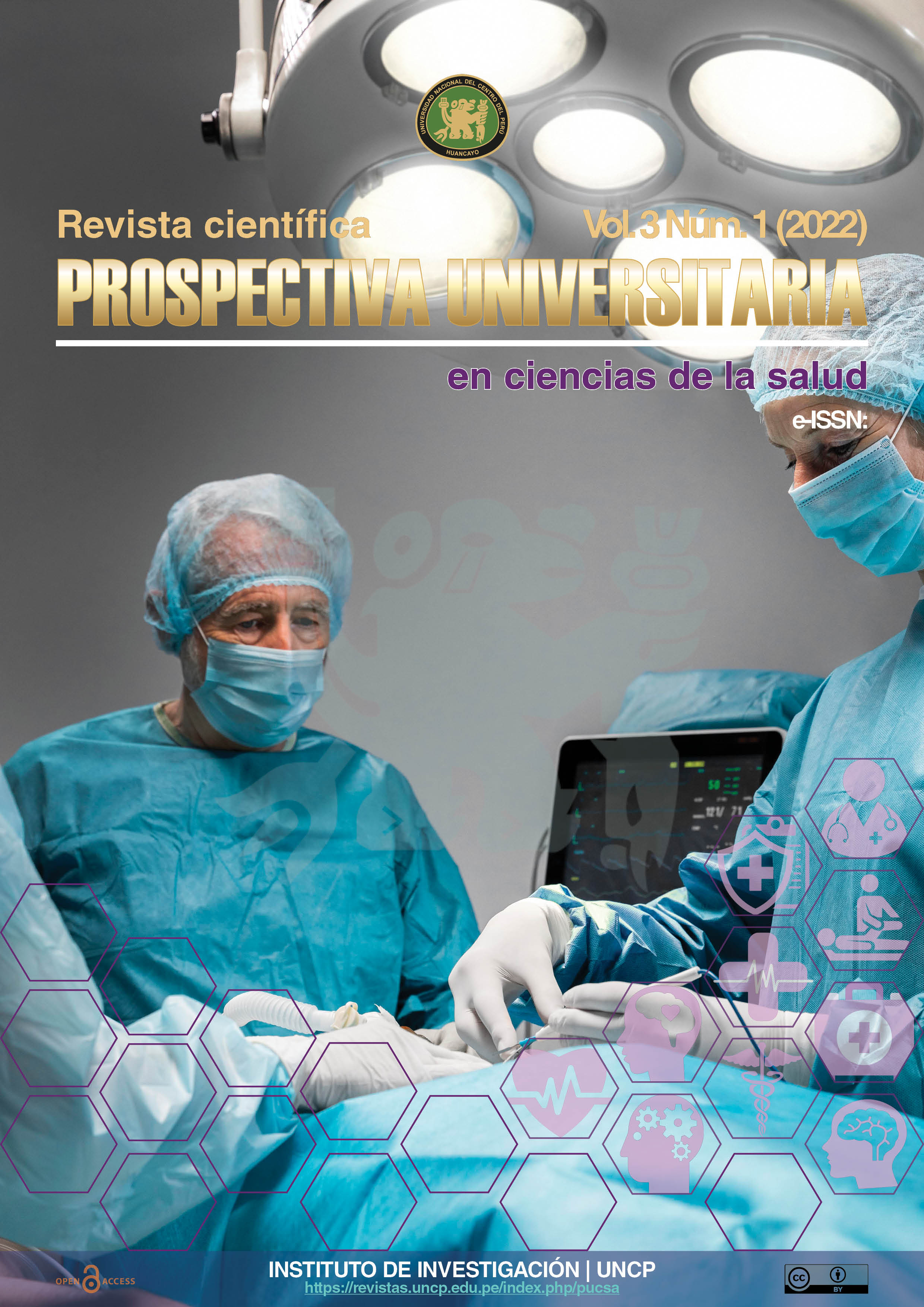Family functioning and pathological gambling in adolescents
Keywords:
Family functioning, Gambling, AdolescenceAbstract
The relationship between family functioning and the level of pathological gambling in adolescents of the Mariscal Castilla educational institution, El Tambo in 2019 was analyzed. The study was a cross-sectional correlational study; the population consisted of 105 high school students aged 13 and 17 years; the ”FACE III” questionnaire was used to assess family functioning; the ”SOUTH OAKS” was also used to assess the level of pathological gambling. The results showed that 49.5% of the adolescents come from chaotic families, followed by 23.8% from flexible families. In adaptability, 39% of the adolescents belong to separated families, followed by 29.5% who are from semi-related families. There is a significant association between family functioning and pathological gambling; Spearman’s Rho (r=-0.4678), p = 0.01. In sum, these results suggest that increasing family functioning decreases the level of pathological gambling in adolescents.
Downloads
References
Bonnaire, C., & Phan, O. (2017). Relationships between parental attitudes, family functioning and Internet gaming disorder in adolescents attending school. Psychiatry Research, 255, 104-110. https://doi.org/10.1016/j.psychres.2017.05.030
Canale, N., Griffiths, M. D., Vieno, A., Siciliano, V., & Molinaro, S. (2016). Impact of Internet gambling on problem gambling among adolescents in Italy: Findings from a large-scale nationally representative survey. Computers in Human Behavior, 57, 99-106. https://doi.org/10.1016/j.chb.2015.12.020
Derevensky, J. L., & Gupta, R. (2007). Internet Gambling Amongst Adolescents: A Growing Concern. International Journal of Mental Health and Addiction, 5(2), 93-101. https://doi.org/10.1007/s11469-007-9057-9
Donati, M. A., Frosini, A., Izzo, V. A., & Primi, C. (2019). The Effectiveness of the Game of Dice Task in Predicting At-Risk and Problem Gambling Among Adolescents: The Contribution of the Neural Networks. Journal of Gambling Studies, 35(1), 1-14. https://doi.org/10.1007/s10899-018-9796-5
González-Roz, A., Fernández-Hermida, J. R., Weidberg, S., Martínez-Loredo, V., & Secades-Villa, R. (2017). Prevalence of Problem Gambling Among Adolescents: A Comparison Across Modes of Access, Gambling Activities, and Levels of Severity. Journal of Gambling Studies, 33(2), 371-382. https://doi.org/10.1007/s10899- 016-9652-4
Gupta, R., & Derevensky, J. L. (2000). Adolescents with Gambling Problems: From Research to Treatment. Journal of Gambling Studies, 16(2/3), 315-342. https://doi.org/10.1023/A:1009493200768
Gupta, R., Nower, L., Derevensky, J. L., Blaszczynski, A., Faregh, N., & Temcheff, C. (2013). Problem Gambling in Adolescents: An Examination of the Pathways Model. Journal of Gambling Studies, 29(3), 575-588. https://doi.org/10.1007/s10899-012-9322-0
Hanss, D., Mentzoni, R. A., Delfabbro, P., Myrseth, H., & Pallesen, S. (2014). Attitudes toward gambling among adolescents. International Gambling Studies, 14(3), 505-519. https://doi.org/10.1080/14459795.2014.969754
King, D. L., & Delfabbro, P. H. (2016). Adolescents’ perceptions of parental influences on commercial and simulated gambling activities. International Gambling Studies, 16(3), 424-441. https://doi.org/10.1080/14459795.2016.1220611
Leeman, R. F., Hoff, R. A., Krishnan-Sarin, S., Patock-Peckham, J. A., & Potenza, M. N. (2014). Impulsivity, Sensation-Seeking, and Part-Time Job Status in Relation to Substance Use and Gambling in Adolescents. Journal of Adolescent Health, 54(4), 460-466. https://doi.org/10.1016/j.jadohealth.2013.09.014
Leong, B. D., Lee, B. Y. H., & Chow, K. K. N. (2018). Collective Play Versus Excessive Use: An Insight into FamilyFocused Design Intervention for Mobile Phone Overuse. International Journal of Mental Health and Addiction, 16(6), 1404-1419. https://doi.org/10.1007/s11469-018-9966-9
Lin, S., Yu, C., Chen, J., Sheng, J., Hu, Y., & Zhong, L. (2020). The Association between Parental Psychological Control, Deviant Peer Affiliation, and Internet Gaming Disorder among Chinese Adolescents: A Two-Year Longitudinal Study. International Journal of Environmental Research and Public Health, 17(21), 8197. https://doi.org/10.3390/ijerph17218197
Lynch, W. J., Maciejewski, P. K., & Potenza, M. N. (2004). Psychiatric Correlates of Gambling in Adolescents and Young AdultsGrouped by Age at Gambling Onset. Archives of General Psychiatry, 61(11), 1116. https://doi. org/10.1001/archpsyc.61.11.1116
Lyu, S. O. (2017). Developmental Process of Internet Gaming Disorder among South Korean Adolescents: Effects of Family Environment and Recreation Experience. Journal of Child and Family Studies, 26(6), 1527-1535. https://doi.org/10.1007/s10826-017-0686-8
Moge, C. E., & Romano, D. M. (2020). Contextualising video game engagement and addiction in mental health: The mediating roles of coping and social support. Heliyon, 6(11), e05340. https://doi.org/10.1016/j.heliyon.2020. e05340
Potenza, M. N., Wareham, J. D., Steinberg, M. A., Rugle, L., Cavallo, D. A., Krishnan-Sarin, S., & Desai, R. A. (2011). Correlates of At-Risk/Problem Internet Gambling in Adolescents. Journal of the American Academy of Child & Adolescent Psychiatry, 50(2), 150-159.e3. https://doi.org/10.1016/j.jaac.2010.11.006
Raisamo, S., Halme, J., Murto, A., & Lintonen, T. (2013). Gambling-Related Harms Among Adolescents: A Population-Based Study. Journal of Gambling Studies, 29(1), 151-159. https://doi.org/10.1007/s10899-012-9298-9
Shaffer, H. J., LaBrie, R., Scanlan, K. M., & Cummings, T. N. (1994). Pathological gambling among adolescents: Massachusetts Gambling Screen (MAGS). Journal of Gambling Studies, 10(4), 339-362. https://doi.org/10.1007/BF02104901
Downloads
Published
Issue
Section
License
Copyright (c) 2024 Carmen Yoni Samaniego Durand, Edith Delia Quispe Mateo, Moisés Jesús Calle Cáceres, Ingrid Magaly Calle Samaniego, Patricia Karolan Corilloclla Yaranga

This work is licensed under a Creative Commons Attribution 4.0 International License.
![IconJournalPUCSA [ENG] by Edgar Julian-Laime®](https://revistas.uncp.edu.pe/public/journals/29/pageHeaderLogoImage_en.png)







